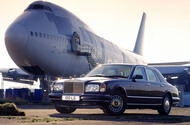The Silver Seraph: A Forgotten Gem in Rolls-Royce History
When you think of Rolls-Royce, images of opulence and engineering excellence likely come to mind. Yet, tucked away in the annals of automotive history is the Silver Seraph, a model that often gets overshadowed by its more illustrious siblings. Released in 1998, the Seraph was the first V12 Rolls-Royce since the 1930s, marking a significant shift for the brand. But what makes this car so intriguing, and why is it gaining newfound appreciation among collectors?
A Challenging Legacy
The backdrop to the Silver Seraph’s creation is a fascinating tale of corporate intrigue and financial struggle. Just before the iconic battle between BMW and Volkswagen for ownership of Rolls-Royce and Bentley, the Crewe-based subsidiary of Vickers was tasked with designing what they hoped would be the next “best car in the world.” This was no small feat, especially considering the company had been grappling with underfunding and outdated designs for years. The Silver Spirit, which had been in production for nearly two decades, was showing its age, and the pressure to innovate was mounting.
The development of the Seraph took almost a decade, a timeline that reflects the challenges the company faced. When it finally arrived, it shared its platform with the Bentley Arnage, but it was equipped with a host of BMW technology, including a 5.4-liter V12 engine and a five-speed automatic transmission. This collaboration was a double-edged sword; while it brought modernity, it also highlighted the compromises made in the design.
A Mixed Bag of Features
Stepping inside the Silver Seraph is like entering a luxurious time capsule. The interior is a lavish display of timber and leather, with a dashboard that resembles fine antique furniture. However, not everything about the Seraph was perfect. Some components, like the switchgear borrowed from the BMW 7 Series, felt out of place in such an extravagant setting. The contrast between the sleek, modern controls and the ornate design of the Rolls-Royce interior was jarring for many enthusiasts.
Performance-wise, the V12 engine promised a lot but delivered a mixed experience. While it was undoubtedly more efficient than the previous pushrod V8, it was designed for a sportier driving style, which didn’t quite align with the expectations of a chauffeur-driven luxury car. The five-speed automatic transmission, while modern, often left drivers waiting for that instant surge of power when needed. This meant that the Seraph was best enjoyed from the back seat, where passengers could appreciate its serene ride and sumptuous interior without worrying about its handling quirks.
A Rarity Worth Considering
Despite its shortcomings, the Silver Seraph has begun to carve out a niche for itself among collectors. With only 1,570 units produced and the model’s relatively short production run of just four years, it’s becoming an appealing oddball in the luxury car market. The final 170 units were limited editions, marking the end of an era for Rolls-Royce as it transitioned to a new chapter under BMW’s ownership.
Today, the Seraph can be found on the used market for surprisingly reasonable prices, often under £35,000 for a decent example. For those seeking a pristine, low-mileage version, you might be looking at just under £60,000. Given its rarity and the unique story behind its creation, the Silver Seraph is starting to stabilize in value, and some experts believe it may even appreciate in the coming years.
The big takeaway? The Silver Seraph isn’t just a footnote in Rolls-Royce history—it’s a fascinating blend of tradition and modernity that deserves a second look. If you’re in the market for a luxury vehicle with a rich backstory and a touch of exclusivity, consider taking a chance on this once-overlooked gem. Start your search, and you might just find a piece of automotive history that’s ready to be cherished.

